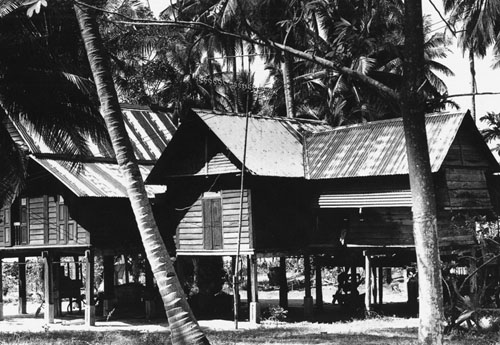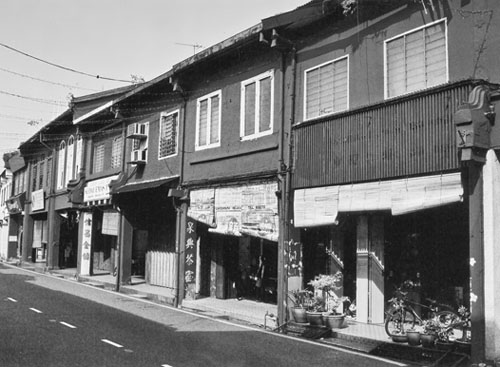Battle Story (11 page)
Authors: Chris Brown

Although the mainland had been evacuated on 31 January, General Yamashita did not press on with an attack immediately. His troops had been fighting continuously for eight weeks and were exhausted. Men had become scattered from their units so had to be located and returned; ammunition stacks had to be replenished and assault craft had to be brought in before he could mount an operation. Although their ammunition supply was low, Yamashita was determined to allow the Allied troops no respite. As such, sporadic and relatively minor artillery bombardments started on 1 February, directed from observation posts on high ground and at least one observation balloon. Such balloons were rather anachronistic by 1942 but the Japanese had virtually complete control of the air so there was little threat of the balloon being shot down.
The Allied artillery was not silent, and sections (two guns) of various regiments were moved around the island (in the hope that the Japanese would not be able to identify their positions quickly enough to arrange counter-battery fire) to deliver harassing fire. They were, however, limited to no more than twenty rounds per day. This restriction had been imposed to preserve ammunition stocks for the main battle since Percival was planning for a struggle of three months, in the hope that a major relief operation could be mounted in that period. With stocks of 25-pounder and anti-aircraft ammunition already running low, Percival felt that he needed to retain as much of an ammunition reserve as possible as there was little prospect of replenishment for several weeks at least. The order would have unfortunate unintended consequences, for it was construed as a general policy for the entire battle rather than a temporary restriction to be observed until the Japanese attempted a landing. The absence of British air support and the firing restrictions allowed the Japanese to regroup and prepare their forces almost with impunity.
Remarkably, no effort had been made to arrange for observers to be left in Johore who could report on Japanese movements by wireless, and there was no realistic possibility of garnering such
intelligence from local sources since the telephone lines to the island had been cut. Even if this had not been the case, it is not at all certain that any information provided by local people would have been taken seriously, nor that it would have been acted on. Deprived of aerial reconnaissance as well as any other form of intelligence material, the Allies were forced to rely on patrols crossing the strait to Johore by night in small boats. There seems to have been no sorties across the strait from the Western Area before 6 February, but there were a number from the Eastern Area, none of which reported any extensive movements of infantry or artillery concentrations. It was not until the night of the 6th that Bennett’s Western Area headquarters was instructed to send patrols across the strait to investigate activity to the west of Johore.


On the night of 7/8th, patrols from 22nd Australian Brigade had managed to cross the strait and reconnoitred about 5 miles of coastline between Sungei Malayu and Sungei Pendas. They had identified a considerable concentration of Japanese infantry units, but little in the way of artillery and no landing craft at all; however, they had not been able to move much more than a mile inland and had been unable to penetrate as far north as Sungei Skudai. The landing craft were certainly being prepared for the assault, but not in the areas to which the patrols could penetrate.
By the morning of 8 February Malaya Command intelligence was confident that a major Japanese attack on the north-western coast between Sungei Berih and Kranji was imminent, but their conclusions were not shared with Bennett’s headquarters until sometime after 1500hrs. Bennett made an immediate and urgent request for an aerial reconnaissance of what he assumed – rightly – to be the Japanese forming-up area, but there were simply no aircraft to be had, and even if there had been there was very little chance that a reconnaissance mission would have been successful
in the face of Japanese air superiority. The best that could be done was to fire a number of speculative concentrations based on the information obtained by the patrols and reasonable deductions. None of this had any discernible impact on Japanese preparations.
WHAT ACTUALLY HAPPENED?
Failure to stop Japanese Twenty-Fifth Army in Malaya did not mean they were undamaged by the campaign. Casualties among the infantry particularly had been considerable, though many of the tanks that had been put out of action had been repaired and returned to units by 8 February. The Japanese lines of communication had stretched beyond capacity despite use of captured vehicles. General Yamashita was forced to pause for a week in Johore to stockpile materials, get engineering equipment to the front and reorganise his units before making an attack.
His plans had to include a role for Guards Division. The division had not acquitted itself especially well in the campaign so far, and Yamashita’s main assault would be conducted by the 5th and 18th Divisions, but the prestige of the Guards Division and the influence of their commanding officer at home obliged Yamashita to put them into the fight, so he decided to use them in an assault on the eastern aspect of the battle as well as the west. The attack was not redundant in that it would help to prevent the Allies from reinforcing the defenders in the Western Area, where the main attack would be pressed, but it would also reduce the availability of landing craft and other resources to support the 5th and 18th Divisions. In total, Yamashita had a force of about 30,000 men. He was heavily outnumbered, short of food and ammunition, and was
not absolutely confident about the attitude of the commander of the Guards Division, Major General Nishimura.
At first glance, Percival appears to have been in a relatively strong position. A wide stretch of water lay between him and the enemy, quite a lot of the coast was covered with mangrove swamp which would be virtually impassable to tanks or transport, and each passing day was an opportunity to add to the pillboxes and gun positions around the island, as well as giving a little more time to rest and reorganise his forces. In reality, his position was already desperate. His force of thirty-eight infantry battalions, three machine-gun battalions and nine field artillery regiments was much less than the sum of its parts. Huge amounts of equipment were lost in the campaign – not just materiel destroyed in combat, but large quantities that had been abandoned due to premature blowing of bridges, failures of transport or that had been captured by rapid Japanese advances. One Japanese unit was already using captured British artillery pieces before the attack on Singapore took place.
Many units had lost heavily during the retreat, and although some manpower shortages could be made up by transferring administrative staff, drivers, cooks and others to the rifle companies, the competence of the unit as a whole was undermined. Percival was further hampered by a determined lack of co-operation on the part of Sir Shenton Thomas and conflicting instructions from Wavell and London. On the one hand he was expected to carry on the fight to the last bullet, on the other he was required to prevent the Japanese from acquiring any supplies and equipment if the island should fall. These two objectives were mutually incompatible. If he was going to fight he would need all the arms, ammunition, food and other materiel that he could muster.
He also made a number of poor policy decisions. He put far too much faith in the sparse chain of fortified positions around
the coast. There was a failure to use all of the assets available, including eighteen light tanks. The vehicles were lightly armed, poorly armoured and positively obsolete, but if they had been moved around the island extensively before the Japanese landing they might possibly have boosted confidence. His plan was to attempt to defend the island from any angle but still retain a large reserve to repel the invasion. However, he had inadequate plans or transport to bring the reserve into battle quickly or effectively, and he was further impeded by a lack of wireless equipment, much of which had been lost on the mainland and extensive damage had been done to the military and civil telephone lines through Japanese bombing and shelling. He had very real intelligence about the enemy’s intentions and Japanese shelling forced the abandonment of all the airfields in the northern part of the island, though by the time the Japanese landed there were only ten Hurricanes and handful of Buffalo fighters still operational – hardly enough to deter bombing raids, let alone provide any support for the troops on the ground.
| 7 February | Japanese troops seize Pulau Ubin and land on Singapore Island. |
8 February | |
| Japanese troops land on Singapore Island in considerable numbers. | |
| Japanese landing forces press inland to the village of Ama Keng. | |
| 2200hrs | Battle commences in the Sarimbun beach area between Japenese forces and 22nd Brigade. |
The first action of the battle for Singapore took place on the night of 7/8 February, when Japanese troops landed on Pulau Ubin, an island about 5 miles long lying in the eastern channel of the Johore Strait. Curiously, although the neighbouring island of Pulau Tekong Besar was garrisoned by 2/17th Dogra Battalion to
protect the two coastal batteries there (Sphinx battery with two 6in guns and Tekong Besar battery with three 9.2in guns), Pulau Ubin does not seem to have figured in the general defence plan for Singapore at all. It was unprotected other than by patrols from the 4th Norfolks, which were immediately withdrawn to Changi.
From dawn onward shelling and air attacks increased steadily, with several air strikes being mounted on the positions held by 22nd Australian Brigade in Western Area. By the early afternoon the Japanese artillery bombardments had become more focused on headquarter assets and virtually all communications within the brigade area had been thoroughly disrupted by dusk. Both Bennett and Percival formed the opinion that this was not an indication of an immediate attack, but rather the beginning of
a prolonged bombardment that might last for some days before the Japanese attempted a landing. Neither were particularly concerned, believing that there would be opportunities to restore communications and repair defences. On account of this assumption, no special effort was made to disrupt Japanese preparations with artillery. This was not entirely irrational. Ammunition supplies were limited and would be required for infantry support once the battle was joined; furthermore, the lack of verifiable targets would mean that any artillery fire would be highly speculative and probably very wasteful.
